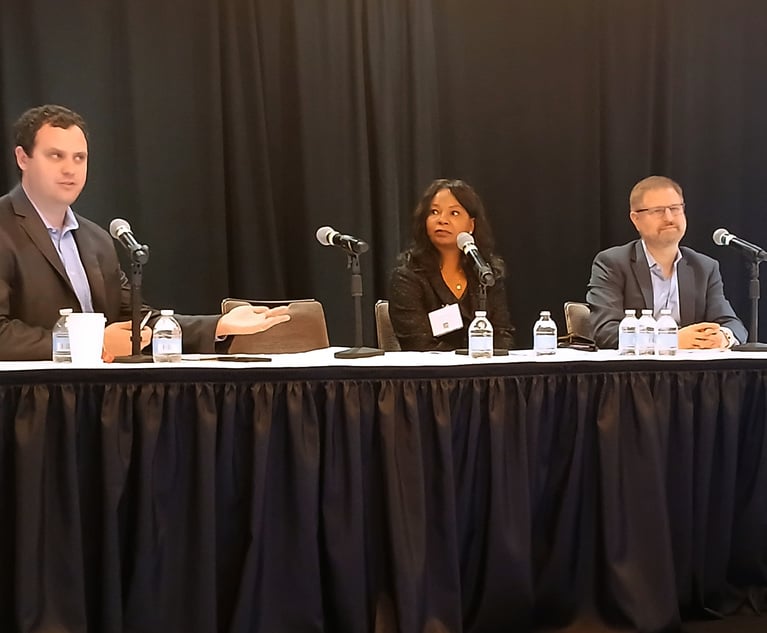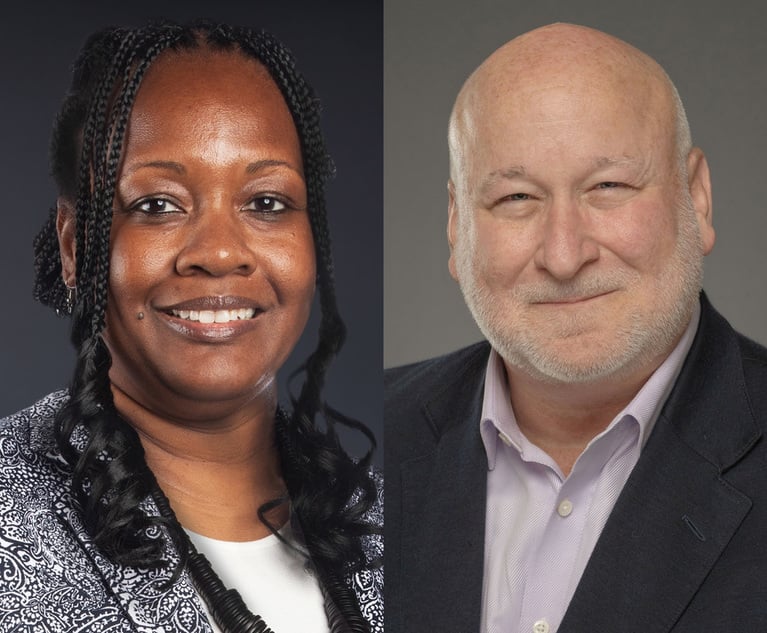Integrity and Personal Conscience Guide Ethical Lawyers
There is more to being an ethical lawyer than following the letter of the Model Rules.
June 30, 2010 at 08:00 PM
7 minute read
The Preamble to the Model Rules of Professional Conduct acknowledges an inherent limitation of any set of behavior rules: They can never envision or predict all the situations that should invoke the rules. Accordingly, the Model Rules appeal to a lawyer's integrity or “personal conscience” to fill gaps, resolve ambiguities and conflicts, and serve as an additive layer atop the minimally acceptable conduct decreed by the Model Rules.
The preamble says, “A lawyer is also guided by personal conscience and the approbation of professional peers. A lawyer should strive to attain the highest level of skill, to improve the law and the legal profession and to exemplify the legal profession's ideals of public service.”
I read this to mean that there is more to being an ethical lawyer than following the letter of the Model Rules. Indeed, the Model Rules are spirited by integrity, and that value envelopes them to assure that lawyers will do right even if the Model Rules are silent or permit less.
Still, lawyers like rules that can be understood and enforced. Principles such as integrity and personal conscience are difficult to define and, therefore, compel within our profession. I recently read a terrific book entitled “There Is No Such Thing as Business Ethics” wherein the author, John C. Maxwell, offers that the Golden Rule should serve as a cross-cultural, well-understood and easy-to-apply integrity guideline.
Maxwell's work notwithstanding, integrity is difficult to define but easy to spot. I recently had two contrasting experiences that confirm that our profession is elevated by integrity-based practices. The first involved my company. We recently announced a settlement of litigation over stock option backdating that had cost the company hundreds of millions of dollars. A proposed settlement was achieved and, in a press account accompanying the announcement, an unnamed lawyer from one of the multitude of firms involved in the litigation offered the following: “I'm sad that I'll be losing my retirement annuity.” I wonder what personal integrity paradigm produced that gem. This type of comment renders the proliferation of lawyer jokes completely understandable.
In contrast to that statement, I recently had the occasion to meet a general counsel who personifies integrity. His name is Tom McCoy, GC of Advanced Micro Devices (AMD). Tom and I participated in a CLE session together. Tom described to me how integrity was the rock upon which he counseled his client through business crises, management changes and litigation battles. Tom views the in-house team as the protectorate of the company's culture and this animates one of his “rules” for his team: Do everything with integrity.
On the role of the general counsel, Tom says, “A general counsel has few boundaries, surveying and counseling across the waterfront of corporate activity. The GC does not set the strategy, although he will cross-examine it and help hone it. The GC is not in charge. He serves as a fiduciary to those in charge. He serves as a lawyer, obviously, but also as a confidante, a professor of common sense, a sounding board, a voice of reason and conscience, a facilitator, a negotiator, a mediator, a protector, a shoulder to cry on (a healer), a truth seeker and a truth teller, a maker and keeper of rules, and above all a lighthouse of values. Whenever necessary, the general counsel is the insistent enforcer of justice. His leadership is prominent, and certainly steadfast, dependable and inspiring. His credibility and integrity are impeccable. … His resources are the armament of the corporation.”
Tom is a role model for the legal profession because his integrity lifts his conduct far beyond that which any set of rules ever could proscribe.
The Preamble to the Model Rules of Professional Conduct acknowledges an inherent limitation of any set of behavior rules: They can never envision or predict all the situations that should invoke the rules. Accordingly, the Model Rules appeal to a lawyer's integrity or “personal conscience” to fill gaps, resolve ambiguities and conflicts, and serve as an additive layer atop the minimally acceptable conduct decreed by the Model Rules.
The preamble says, “A lawyer is also guided by personal conscience and the approbation of professional peers. A lawyer should strive to attain the highest level of skill, to improve the law and the legal profession and to exemplify the legal profession's ideals of public service.”
I read this to mean that there is more to being an ethical lawyer than following the letter of the Model Rules. Indeed, the Model Rules are spirited by integrity, and that value envelopes them to assure that lawyers will do right even if the Model Rules are silent or permit less.
Still, lawyers like rules that can be understood and enforced. Principles such as integrity and personal conscience are difficult to define and, therefore, compel within our profession. I recently read a terrific book entitled “There Is No Such Thing as Business Ethics” wherein the author, John C. Maxwell, offers that the Golden Rule should serve as a cross-cultural, well-understood and easy-to-apply integrity guideline.
Maxwell's work notwithstanding, integrity is difficult to define but easy to spot. I recently had two contrasting experiences that confirm that our profession is elevated by integrity-based practices. The first involved my company. We recently announced a settlement of litigation over stock option backdating that had cost the company hundreds of millions of dollars. A proposed settlement was achieved and, in a press account accompanying the announcement, an unnamed lawyer from one of the multitude of firms involved in the litigation offered the following: “I'm sad that I'll be losing my retirement annuity.” I wonder what personal integrity paradigm produced that gem. This type of comment renders the proliferation of lawyer jokes completely understandable.
In contrast to that statement, I recently had the occasion to meet a general counsel who personifies integrity. His name is Tom McCoy, GC of
On the role of the general counsel, Tom says, “A general counsel has few boundaries, surveying and counseling across the waterfront of corporate activity. The GC does not set the strategy, although he will cross-examine it and help hone it. The GC is not in charge. He serves as a fiduciary to those in charge. He serves as a lawyer, obviously, but also as a confidante, a professor of common sense, a sounding board, a voice of reason and conscience, a facilitator, a negotiator, a mediator, a protector, a shoulder to cry on (a healer), a truth seeker and a truth teller, a maker and keeper of rules, and above all a lighthouse of values. Whenever necessary, the general counsel is the insistent enforcer of justice. His leadership is prominent, and certainly steadfast, dependable and inspiring. His credibility and integrity are impeccable. … His resources are the armament of the corporation.”
Tom is a role model for the legal profession because his integrity lifts his conduct far beyond that which any set of rules ever could proscribe.
This content has been archived. It is available through our partners, LexisNexis® and Bloomberg Law.
To view this content, please continue to their sites.
Not a Lexis Subscriber?
Subscribe Now
Not a Bloomberg Law Subscriber?
Subscribe Now
NOT FOR REPRINT
© 2024 ALM Global, LLC, All Rights Reserved. Request academic re-use from www.copyright.com. All other uses, submit a request to [email protected]. For more information visit Asset & Logo Licensing.
You Might Like
View All
GC Conference Takeaways: Picking AI Vendors 'a Bit of a Crap Shoot,' Beware of Internal Investigation 'Scope Creep'
8 minute read
Why ACLU's New Legal Director Says It's a 'Good Time to Take the Reins'

'Utterly Bewildering': GCs Struggle to Grasp Scattershot Nature of Law Firm Rate Hikes
Trending Stories
Who Got The Work
Michael G. Bongiorno, Andrew Scott Dulberg and Elizabeth E. Driscoll from Wilmer Cutler Pickering Hale and Dorr have stepped in to represent Symbotic Inc., an A.I.-enabled technology platform that focuses on increasing supply chain efficiency, and other defendants in a pending shareholder derivative lawsuit. The case, filed Oct. 2 in Massachusetts District Court by the Brown Law Firm on behalf of Stephen Austen, accuses certain officers and directors of misleading investors in regard to Symbotic's potential for margin growth by failing to disclose that the company was not equipped to timely deploy its systems or manage expenses through project delays. The case, assigned to U.S. District Judge Nathaniel M. Gorton, is 1:24-cv-12522, Austen v. Cohen et al.
Who Got The Work
Edmund Polubinski and Marie Killmond of Davis Polk & Wardwell have entered appearances for data platform software development company MongoDB and other defendants in a pending shareholder derivative lawsuit. The action, filed Oct. 7 in New York Southern District Court by the Brown Law Firm, accuses the company's directors and/or officers of falsely expressing confidence in the company’s restructuring of its sales incentive plan and downplaying the severity of decreases in its upfront commitments. The case is 1:24-cv-07594, Roy v. Ittycheria et al.
Who Got The Work
Amy O. Bruchs and Kurt F. Ellison of Michael Best & Friedrich have entered appearances for Epic Systems Corp. in a pending employment discrimination lawsuit. The suit was filed Sept. 7 in Wisconsin Western District Court by Levine Eisberner LLC and Siri & Glimstad on behalf of a project manager who claims that he was wrongfully terminated after applying for a religious exemption to the defendant's COVID-19 vaccine mandate. The case, assigned to U.S. Magistrate Judge Anita Marie Boor, is 3:24-cv-00630, Secker, Nathan v. Epic Systems Corporation.
Who Got The Work
David X. Sullivan, Thomas J. Finn and Gregory A. Hall from McCarter & English have entered appearances for Sunrun Installation Services in a pending civil rights lawsuit. The complaint was filed Sept. 4 in Connecticut District Court by attorney Robert M. Berke on behalf of former employee George Edward Steins, who was arrested and charged with employing an unregistered home improvement salesperson. The complaint alleges that had Sunrun informed the Connecticut Department of Consumer Protection that the plaintiff's employment had ended in 2017 and that he no longer held Sunrun's home improvement contractor license, he would not have been hit with charges, which were dismissed in May 2024. The case, assigned to U.S. District Judge Jeffrey A. Meyer, is 3:24-cv-01423, Steins v. Sunrun, Inc. et al.
Who Got The Work
Greenberg Traurig shareholder Joshua L. Raskin has entered an appearance for boohoo.com UK Ltd. in a pending patent infringement lawsuit. The suit, filed Sept. 3 in Texas Eastern District Court by Rozier Hardt McDonough on behalf of Alto Dynamics, asserts five patents related to an online shopping platform. The case, assigned to U.S. District Judge Rodney Gilstrap, is 2:24-cv-00719, Alto Dynamics, LLC v. boohoo.com UK Limited.
Featured Firms
Law Offices of Gary Martin Hays & Associates, P.C.
(470) 294-1674
Law Offices of Mark E. Salomone
(857) 444-6468
Smith & Hassler
(713) 739-1250







